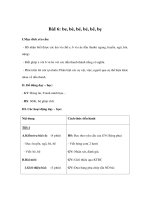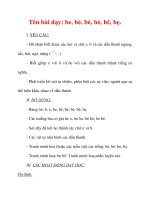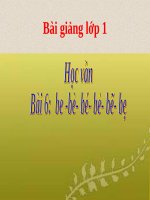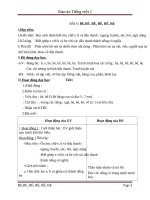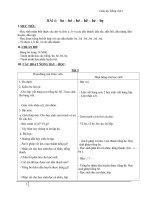CAMBRIDGE PRIMARY MATHEMATICS 1 HỌC TOÁN BẰNG TIẾNG ANH CHO BÉ
Bạn đang xem bản rút gọn của tài liệu. Xem và tải ngay bản đầy đủ của tài liệu tại đây (30.46 MB, 93 trang )
CAMBRIDGE
UNIVERSITY
PRESS
ENDORSED BY
B CAMBRIDGE
International Examinations
CAMBRIDGE
PRIMARY
Mathematics
Learner’s Book
Cherri Moseley and Janet Rees
ah
os
a
NT
GE
TY PRES
CAMBRIDGE
UNIVERSITY PRESS
University Printing House, Cambridge cB2 88s, United Kingdom
Cambridge University Press is part of the University of Cambridge.
It furthers the University’s mission by disseminating knowledge in the pursuit of
education, learning and research at the highest international levels of excellence.
Information on this title: education.cambridge.org
© Cambridge University Press 2014
This publication is in copyright. Subject to statutory exception
and to the provisions of relevant collective licensing agreements,
no reproduction of any part may take place without the written
permission of Cambridge University Press.
First published 2014
4th printing 2015
Printed in Dubai by Oriental Press
A catalogue record for this publication is available from the British Library
ISBN 978-1-107-63131-1
Paperback
Cambridge University Press has no responsibility for the persistence or accuracy
of URLs for external or third-party internet websites referred to in this publication,
and does not guarantee that any content on such websites is, or will remain, accurate
or appropriate.
RE
eee
RRR
E REE
REE
ORE
ƠƠƠƠƠƠƠƠƠƠƠƠƠƠƠƠƠƠƠƠƠƠƠÍƠ
NOTICE TO TEACHERS
His illegal to reproduce any part of this work in material form (including
photocopying and electronic storage) except under the following circumstances:
(i) where you are abiding by a licence granted to your school or institution by the
Copyright Licensing Agency;
{ii) where no such licence exists, or where you wish to exceed the terms of a license,
and you have gained the written permission of Cambridge University Press;
(iii) where you are allowed to reproduce without permission under the provisions
of Chapter 3 of the Copyright, Designs and Patents Act 1988, which covers, for
example, the reproduction of short passages within certain types of educational
anthology and reproduction for the purposes of setting examination questions.
FRA
HAT
EERE
HAT
ERE
RETO
EEE
TR
ERR
ee
EEE
EE
The authors and publishers acknowledge the following sources of copyright material
and are grateful for the permissions granted. While every effort has been made, it has
not always been possible to identify the sources of all the material used, or to trace
all copyright holders. If any omissions are brought to our notice, we will be happy to
include the appropriate acknowledgements on reprinting.
PHOTOGRAPHS
pp. 11/,b, 84 Janet Rees; p. 23! kmt_rf/Alamy; p. 23fr danako/Alamy; p. 23b/ Melinda
Fawver/Thinkstock; p. 23br Dvpdt/Shutterstock; p. 46t/ Trimages/Thinkstock; p.
46tr GrASa Victoria/ Thinkstock; p. 46cl aerogondo/Thinkstock; p. 46cr Kasper
Christiansen/Thinkstock; p. 461 Getty Images/Thinkstock; p. 46bc Sergey Galushko/
Thinkstock; p. 466r studioraffi/Thinkstock; p. 55! BananaStock/Thinkstock;
p. 55tr ChrisPole/Thikstock; p. 55bf Chad Davis/Thinkstock; p. 55 br DNHanlon/
Thinkstock; p. 78¢ Baloncici/Thinkstock; p. 78¢r vora/Thinkstock; p. 78b! Claus
Mikosch/Thinkstock; p. 786r Keith Levitt/Thinkstock
t= top c= centre b = bottomI = left r = right
Introduction
This Learner's Book is a supplementary resource that
consolidates and reinforces mathematical learning
alongside the Cambridge Primary Mathematics
Teacher’s Resource 1 (9781107656833). It acts as a useful
consolidation tool for the learners by providing points
for discussion to develop problem-solving skills and
support learning through discovery and discussion.
Rote learning and drill exercises are avoided.
Ideally, a session should be taught using the appropriate
Core activity in the Teacher's Resource 1, with the
Learner's Book page open during the session as a visual
reference and/or guide for the learner. There are
sometimes simple questions or activities that could be
used to assess learner understanding. There is a single
page corresponding to each Core activity in the Teacher's
Resource 1 printed book. The Core activity that the page
relates to is indicated at the bottom of the page.
Hints and tips are provided throughout to support the
learners. They will appear as follows:
i
Write a list of number
pairs to help you
-
Please note that the Learner’ Book on its own does
not cover all of the Cambridge Primary mathematics
curriculum framework for Stage 1. It needs to be used
in conjunction with the Teacher’ Resource 1. The
Teacher's Resource 1 and Learner’s Book 1 do not follow
the order of the Cambridge Primary mathematics
curriculum framework. Although all of the objectives
in the framework are covered, they are approached in a
different order.
This publication is part of the Cambridge Primary Maths
project. Cambridge Primary Maths is an
=e)
dill
innovative combination of curriculum and
resources designed to support teachers and
learners to succeed in primary mathematics
through best-practice international maths teaching and
a problem-solving approach.
Cambridge Primary Maths brings together the worldclass Cambridge Primary mathematics curriculum from
Cambridge International Examinations, high-quality
publishing from Cambridge University Press and
expertise in engaging online enrichment materials for
the mathematics curriculum from NRICH.
Teachers have access to an online tool that maps
resources and links to materials offered through
the primary mathematics curriculum, NRICH and
Cambridge Primary mathematics textbooks and
e-books. These resources include engaging online
activities, best-practice guidance and examples of
Cambridge Primary Maths in action.
The Cambridge curriculum is dedicated to helping
schools develop learners who are confident, responsible,
reflective, innovative and engaged. It is designed to
give learners the skills to problem solve effectively,
apply mathematical knowledge and develop a holistic
understanding of the subject.
The Cambridge Primary Maths textbooks provide
best-in-class support for this problem-solving approach,
based on pedagogical practice found in successful
schools across the world. The engaging NRICH online
resources help develop mathematical thinking
and problem-solving skills. To get involved visit
www.cie.org.uk/cambridgeprimarymaths
The benefits of being part of Cambridge Primary
Maths are:
e the opportunity to explore a maths curriculum
founded on the values of the University of Cambridge
and best practice in schools
* access to an innovative package of online and print
resources that can help bring the Cambridge Primary
mathematics curriculum to life in the classroom.
‘This series is arranged to ensure that the curriculum
is covered whilst allowing teachers to use a flexible
approach. The Scheme of Work for Stage 1 has been
followed, though there are a few deviations. The
components are:
e Teacher's Resource 1 ISBN: 9781107656833
(printed book and CD-ROM).
e Learner’s Book 1 ISBN: 9781107631311
(printed book)
e Games Book 1 ISBN: 9781107646407
(printed book and CD-ROM).
Unit 1A Core activity 1.1 Recognising
and saying numbers
up to ten
Up to Ten
How many in each group?
Unit
1A Core
activity
1.2 Counting
to ten
Vocabulary
Make
ten
Find two numbers to make ten.
Ễ
Find three numbers to make ten.
8s
†en frame
Ten take away
How many are there left?
Doubles
Double 1 makes 2.
®
Vocabulary
"
®|
double
| | Ì | efee
Seg
Double 2 makes 4.
©
@
——s
J
=
What other doubles can you find?
Giant fooiprints
ewer
Vocabulary
longer —~
@
os
—
a
__
ae
a
=
How long is your footprint?
How long is the giant’s footprint?
bE
Unit 1C Core activity 3.1 Measuring length
I
I PY
|
Unit 1C Core activity 3.1 Measuring length
Number
pdirs
This is a number pair for
number pairs:
4%
9 and | is a number
|
pair to 6.
This is a number pair for
4and3isanumber
Pair 16:7.
This is a number pair for
?
®
. This is a number pair for
PЧ ø
Unit
1A Core
activity
4.1
Number
pairs fess than ten
;
?
&
|
Write the teen numbers in the correct order.
Vocabulary
teen numbers:
|
are made of ten and
|
all the numbers that
:
some ones.
Use a number track
tohelp you.
ải)
|
]
5
|
Estimate
estimate: ( Kỳ
and
count
Twice as many?
S| es—)
twice as many
eee)
j
twice as many
Is this twice as many?
ES
Sea
đà
twice as many
How do you know?
|
Ị
|
What
Is the shape?
circle
triangle
—
ff
oe
as
—=
t
bes ae
Unit
1B Cor
3)
ay/\X
Making four squares
You will need:
sticks
a pencil or chalk
Lares
+
Q
pentagon
hexagon
You can draw the squares too.
You could make or draw other shapes.
&
triangle
pentagon
hexagon
we
`
4
J
_—
all
What solids can you make by putting these
Gyre
2D shapes together?
ae
cube
“Wy | CU `
cuboid
MAAAA~? --
`,
e
cone
®
triangular prism
What
is next?
MẰ@M@M2
ABABA?
ololok?
Vocabulary
~reer
=
Qa,
A@G@AG?
HOR7TO?7 00700
VHV?VHEV???
`
SY
TẢ
@
seal
TTT
!
_ẢÌ
+
.
x
}
J
=
\
LƠ
<
Ỉ
4
and
patti
ir
-jig
—
=
J _#
Vocabulary
pattern
symmetrical
Jigsaws
Which number pair for seven is missing?
Find the number pairs that are the same.
Unit 1A Core
activity
7.1 Number
pairs to ten
The 100 square
What number patterns can you see in the 100 square?
Unit 1A Core activity 7.2 Beyond
20
Capacity |
Look at these pictures:
|!
|
|
!
!
!
!
|
Ordering capacity
holds most
holds least


